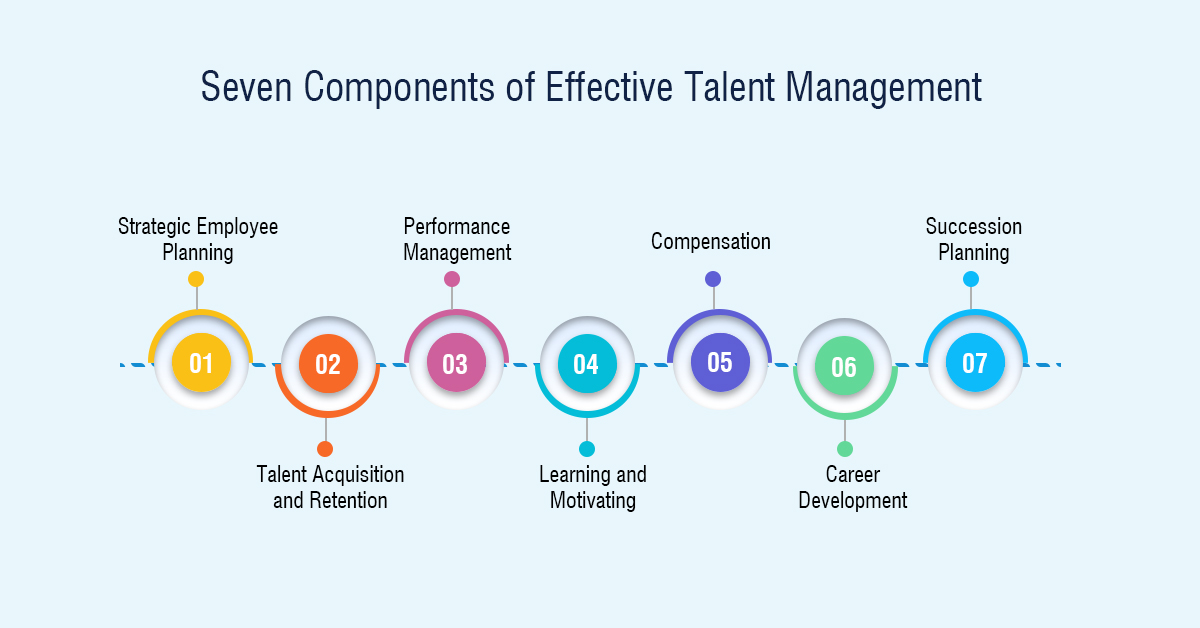
It is 2024, and you must stop taking talent management for granted. 99% of the companies in 2023 had confronted some sort of talent crisis.
If you're seeking to enhance your talent management strategy to proactively address challenges in 2024, you're on the right track. Talent management seldom occurs organically. What's required is a tailored strategy that includes key components i.e., Strategic Employee Planning, Talent Acquisition, Retention, and Employee Performance, all tailored to your company's specific needs for success.
Just as each company has its unique flair, strategies for operational talent management can vary. Yet, they all encompass the key components which we’ll be discussing in this blog.
Understanding Talent Management
Talent Management is how you strategically recruit and retain an employee whose skills align with your business goals and culture. It involves coordinating various organizational processes to attract, nurture, and keep employees.
And it's not just about having talented employees, but ensuring they fit their roles to avoid inefficiencies. The main goal is optimal business outcomes through collaboration, balancing employee growth, human connection, and organizational objectives.
Seven Main Components of Effective Talent Management
Talent management is decisive and is an inherent part of an organization. As effective talent acquisition manifests for long-term success for both––employee and employer, these seven main components have a significant role–

Let's explore these components in detail -
- Strategic Employee Planning: Effective talent management begins with strategic planning. In every workforce, individual strengths and weaknesses contribute to the overall success of a business or project. Recognizing and leveraging these qualities is integral to talent management. Begin by delineating the goals and desired outcomes of the project, aligning them with business goal planning. Subsequently, identify roles and employees, who contribute to the project and facilitate goal attainment.
- Talent Acquisition and Retention: While external talent searches are sometimes necessary, they come with inherent drawbacks such as time consumption and increased risk. Optimal practice involves prioritizing acquiring and retaining high-quality talent and fostering internal hires. Internal recruitment proves more cost-effective and efficient, emphasizing the importance of assessing long-term potential and investing in training strategies for existing staff.
- Performance Management: Aligning individuals with roles that capitalize on their strengths is crucial for business success and elevated staff morale. Understanding employee strengths enables effective deployment, while misalignment may lead to underperformance. You must identify suitable positions for each employee to foster optimal results and cultivate a positive work environment.
- Learning and Motivating: Securing valuable staff is only part of the equation; maintaining their satisfaction and motivation is equally important. Balancing leadership and training are fundamental, with training focusing on task-specific skills and overall skills and experience development. This balance ensures a satisfied workforce committed to personal and professional growth.
- Compensation: Beyond basic salary, acknowledging and appreciating employees' contributions is essential for sustained motivation. Aligning strategic goals with incentives recognizes and rewards significant employee efforts. This fosters a culture of performance and healthy competition within your workforce.
- Career Development: A successful recruiting program is marked by employees who engage with training initiatives, progress within the organization and contribute to its growth. Offering a clear career path, promotion opportunities, and ample training options ensures a workforce invested in the company's long-term success.
- Succession Planning: Maintaining consistency and profitability within an organization requires well-thought succession planning. You are to identify pivotal roles and ensure equivalent replacements are in place through strategic recruitment and training to safeguard your organization against disruptions caused by retirements or departures, contributing to sustained success.
Strategies to Implement Talent Management Components
Before embarking on the launch of your recruitment and talent management strategy, ensure the incorporation of essential components that form the backbone of an effective talent management strategy. There exist five fundamental principles or strategies that resonate with the components of talent management-
- Elevating Workplace Culture: Though not a new strategy, yet one that leaves a lasting impact. Elevating the workplace culture as a top priority creates an environment where employees not only excel in their roles but also feel a profound sense of belonging. A content and engaged workforce tend to contribute meaningfully to their work and demonstrates an increased commitment to their roles.
- Fostering Growth Opportunities: As you recognize your employee’s aspirations for career progression, you should provide ample growth opportunities. This involves offering visibility into potential career paths and establishing healthy support mechanisms for professional development–– fostering a culture of continuous learning.
- Recognizing Employee Strengths: Valuing and leveraging the strengths of each employee is crucial for optimizing engagement and efficiency. Aligning individuals with roles that capitalize on their strengths contributes to a more productive and satisfied workforce.
- Ensuring Fair Compensation Practices: Organizations need to maintain accurate, real-time benchmarks on compensation data specific to industry and geographic region. Ensuring fair compensation attracts top talent and retains it— fostering a stable and motivated workforce.
- Embracing Diversity in Recruitment: Acknowledging the manifold benefits of diversity, organizations actively seek to build teams from a broad talent pool. Embracing diverse perspectives enhances problem-solving capabilities, signaling an organization's commitment.
Conclusion
Companies are increasingly understanding the significance of an all-encompassing talent acquisition strategy that goes beyond mere alignment with organizational goals. And when an organization's talent strategy falls short, in one go it signals a misalignment between employer and employee expectations. The usefulness of any talent strategy is rooted in its capacity to fulfill the exact desires and needs of employees.



